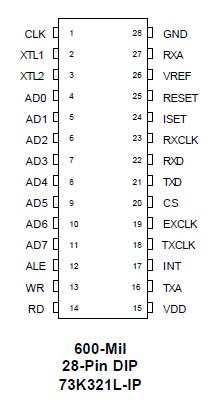73K321L: Features: · One-chip CCITT V.23 and V.21 standardcompatible modem data pump· Full-duplex operation at 0-300 bit/s (V.21) or0-1200 bit/s (V.23) forward channel with orwithout 0-75 bits/s back channel...
floor Price/Ceiling Price
- Part Number:
- 73K321L
- Supply Ability:
- 5000
Price Break
- Qty
- 1~5000
- Unit Price
- Negotiable
- Processing time
- 15 Days
SeekIC Buyer Protection PLUS - newly updated for 2013!
- Escrow Protection.
- Guaranteed refunds.
- Secure payments.
- Learn more >>
Month Sales
268 Transactions
Payment Methods
All payment methods are secure and covered by SeekIC Buyer Protection PLUS.

 73K321L Data Sheet
73K321L Data Sheet







